 Brandinfo
Brandinfo

When is the best season to visit Fansipan?
Standing at a height of 3,143 meters, Fanispan is the highest summit in the Indochinese Peninsula (Laos, Cambodia and Vietnam) and a national icon for the Vietnamese people. In recent years, more and more international tourists have been flocking to northern Vietnam to ascend this vast mountain.
Is there an optimal time of year to visit? Many travellers love to go in spring, when hundreds of cherry and plum blossom trees are in full bloom, lending a poetic beauty to the mountain slopes. In late April, as spring gracefully transitions into early summer, many varieties of azalea – known as the 'Queen of Northwest flowers’ – transforms Fanispan with a vivid red tapestry which captivates visitors.
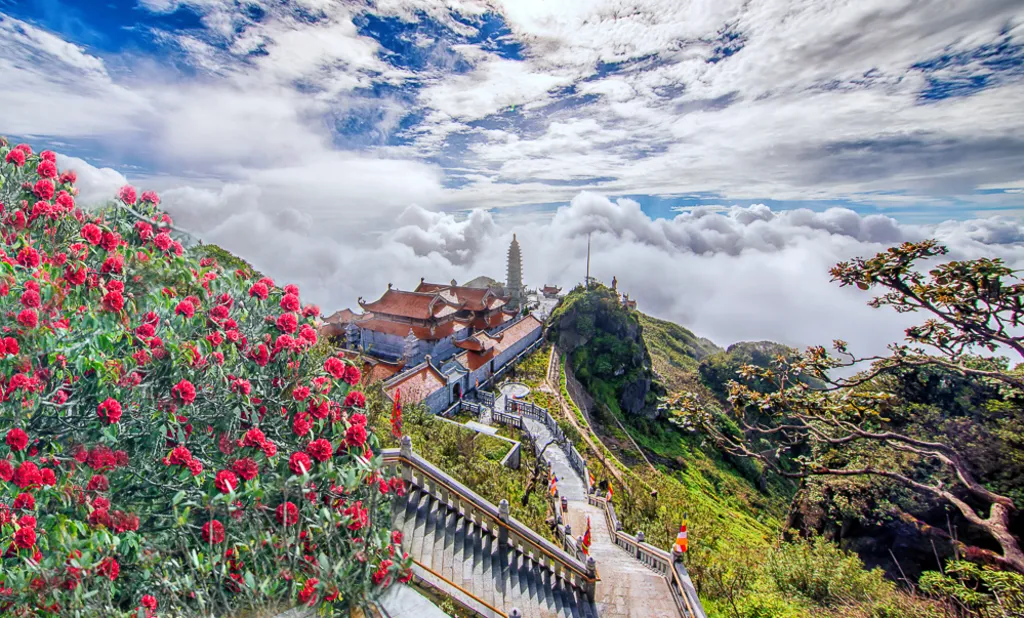 |
| Colours of azalea lend a poetic beauty to Fansipan |
During the summer months, when bustling cities such as Hanoi and Danang are subjected to intense heat, a trip to Sapa, the gateway town to Vietnam's northwest, and Fanispan is considered the perfect getaway. Standing on "the rooftop of Indochina", travellers will discover crisp, cool and pure air with temperatures dipping below 20 degrees Celsius. Affectionately known to Vietnamese as “Golden Season” or “Harvest Season”, autumn is also an incredible time to visit Sapa. At this time of year, the terraced rice fields, where the rice is ripening and golden, seem to cascade down the mountains like a waterfall. It's a dreamscape for professional and amateur photographers.
But wintertime visitors to Sapa may get to experience an extraordinary sight for a tropical country – a snow-covered mountainous landscape that would be more commonly associated with the Swiss Alps.
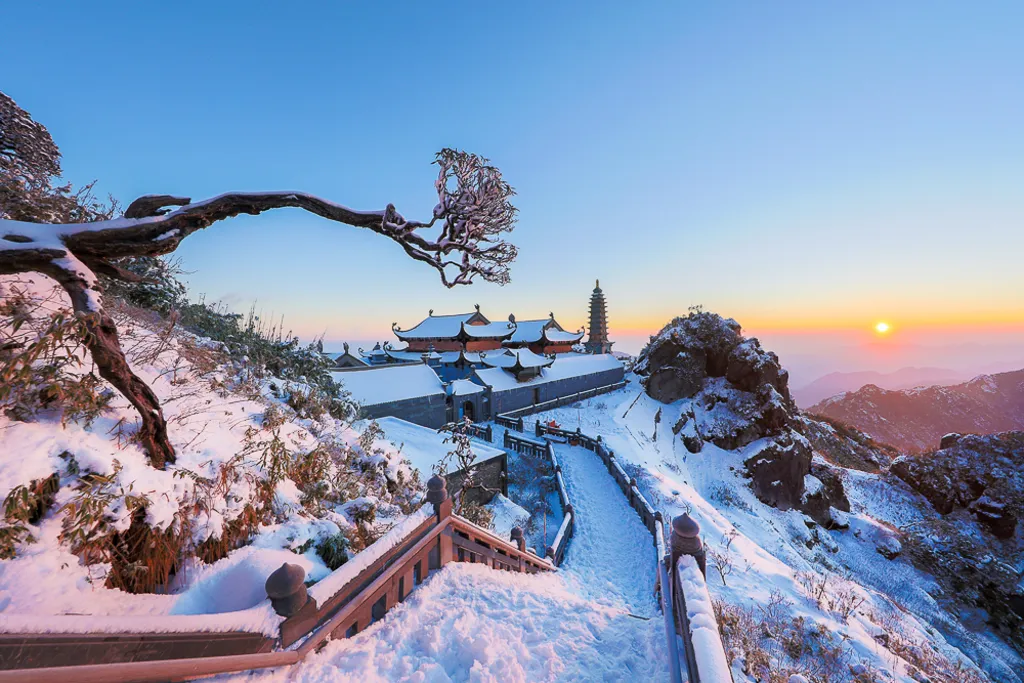 |
| A snow blanket on the “rooftop of Indochina”. Photo courtesy of Vu Minh Quan |
When is the best season to visit? Rest assured, no matter what time of year you visit, Fansipan – one of the most photographed mountains in the world – always puts on a show!
What's the best way to climb Fansipan?
Just a decade ago, climbing up Fansipan presented a huge physical and logistical challenge. Indeed, you would have to embark on a two to three-day trek, walking for over 40 kilometres through wild forests and relying on local H'Mong porters who marked the trail as they went along. However, in 2016, thanks to the inauguration of a cable car system, the journey for travellers to the summit of Fansipan was reduced to around 25 minutes (the arrivals station is just below the peak).
Developed by Sun Group, in collaboration with Doppelmayr Garaventa, the world's leading manufacturer of ropeways, installing the system was an incredible feat of engineering that required great courage and tremendous innovation. Recognised by Guinness World Records as the world’s longest three-rope cable car (6,292.5 meters), the system ascends for 1,410 meters (also a world record) and it's an exhilarating experience for travellers of all ages as the cable car glides through the ethereal clouds.
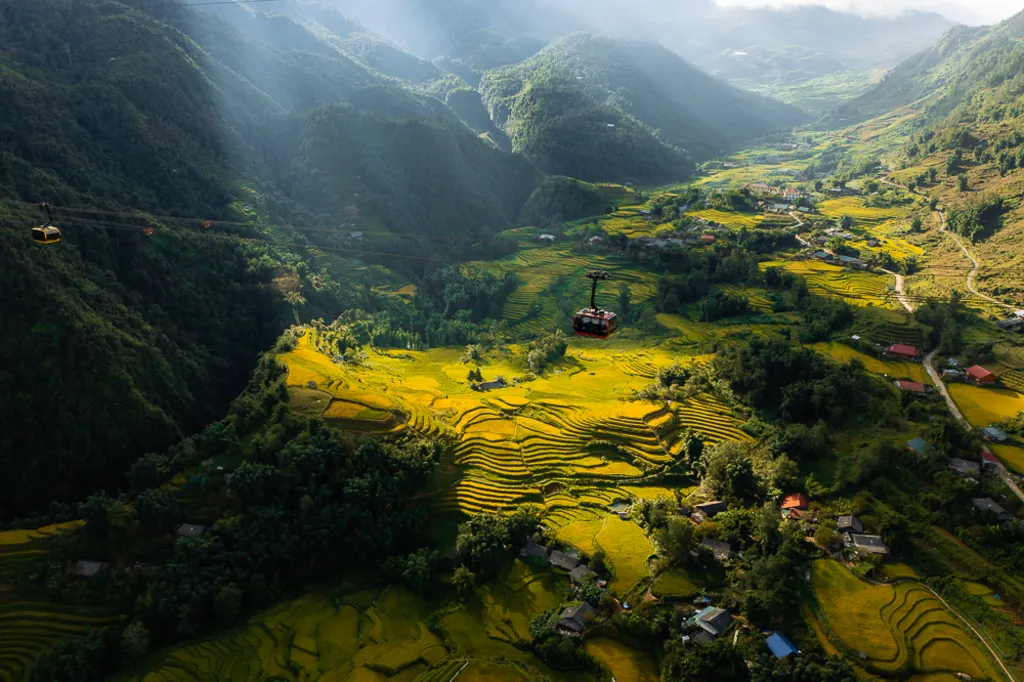 |
| The Fansipan cable car system opens up an unparalleled opportunity for visitors to admire the breathtaking beauty of the Muong Hoa Valley from an elevated perspective |
This visionary cable car system means more visitors than ever before have been able to reach the top of Fanispan and admire the breathtaking beauty of the Hoang Lien Mountain range all around and the Muong Hoa Valley down below.
Before they ascend the mountain, travellers can also take a fun train trip from the heart of Sapa town to the cable car station. The elegant red locomotive, which has a beautiful vintage charm, winds its way through the Muong Hoa Valley where many ethnic minority communities including the H'Mong and Dao are nestled among the mountain slopes in rustic hamlets.
Currently, combo tickets for the cable car and train ride are available, starting from $50 per adult and $40 per child at Sun World Fansipan Legend.
'What's the best time of day to conquer Fansipan?'
If you go in the morning, it's a majestic, perhaps even spiritual sight when you rise up through the clouds and see how the earth and sky converge as one in the soft morning light. It can also feel life-affirming when standing at the summit and admire a new day in such a beautiful part of the world. If you go in the early afternoon, you can spend an hour or two enjoying the spectacular scenery and visiting the spiritual complex on the mountain top, and then… it's show time! As the sun begins to set, you will be treated to an enchanting blend of colours over the Hoang Lien Mountain range. Indeed, the beauty of a sunset seen from the top of Fansipan is almost surreal. For that reason, the afternoon is the preferred time of day for many travellers. But early risers would surely love to start the dawning of a new day from such a height.
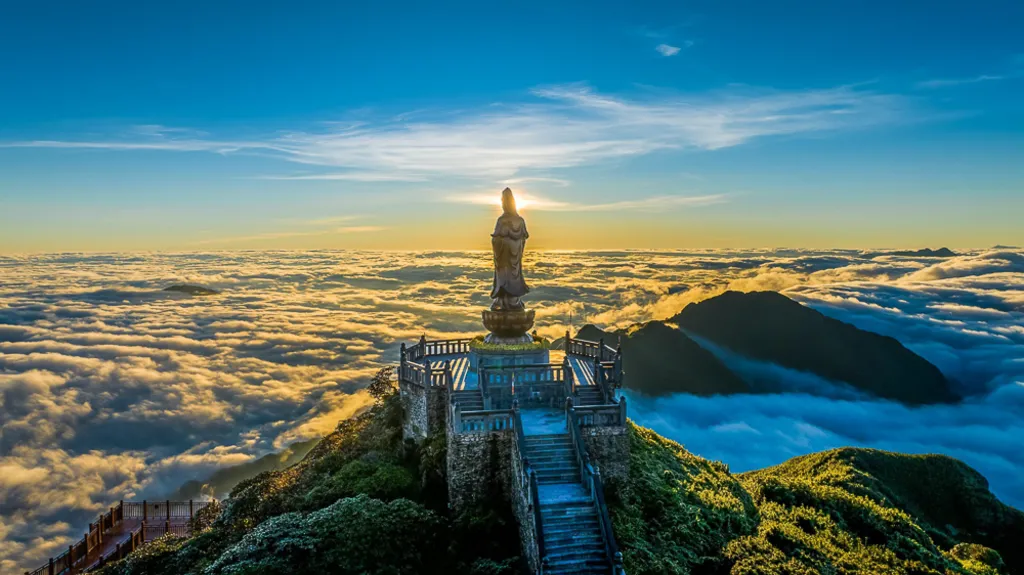 |
| A beauty of Fansipan in “cloud hunting” season. Photo courtesy of Hoang Trung Hieu |
On the summit of Vietnam's highest peak, visitors will discover a steel pyramid inscribed with the words “FANSIPAN 3,143M”, a gift from an adventure-loving community to Hoang Lien Son National Park in 2008. Much like the iconic elevation markers found on other famous peaks around the world, this spot serves as a cherished photography spot for all visitors reaching the summit of Fansipan. Additionally, you will come across the National Flagpole. If you ascend the mountain in the morning on special occasions, national holidays, or the weekend, you will get to witness a flag-raising ceremony. For international tourists, the flag-raising ceremony presents a memorable cultural experience, one that reflects the Vietnamese people's national pride and the country's historic sovereignty.
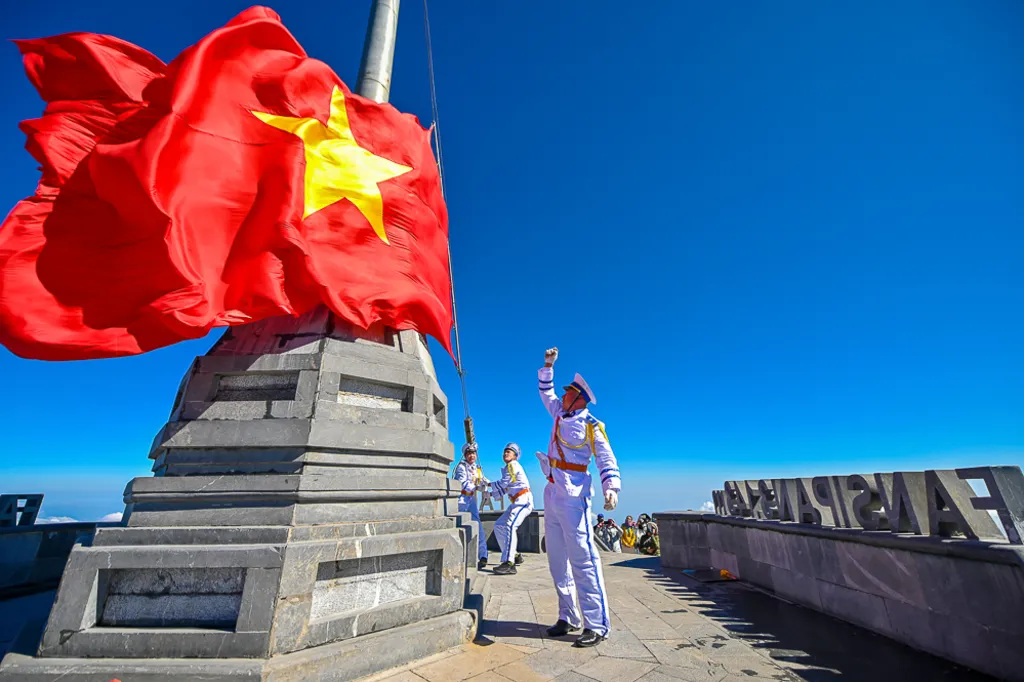 |
| Flag-raising ceremony on Fansipan |
Upon leaving the cable car arrivals station, visitors can explore a spiritual complex, which boasts 12 architectural works that were inspired by Vietnamese temples from the 15th and 16th centuries. Over 100,000 tons of Ninh Binh green stone, along with more than 2,000 cubic meters of precious wood, and tens of thousands of restored tiles and bricks were incorporated into the design of the structures, which were carefully conceptualized to be in sync with the mountain's natural form.
Perched at an altitude of 3,091 meters, Kim Son Bao Thang Temple is the largest structure within the spiritual and cultural complex of Fansipan. It embodies the architectural essence of ‘Noi Cong Ngoai Quoc’ style, a signature trait of traditional Vietnamese temples. Surrounded by white clouds, many visitors have remarked that Kim Son Bao Thang Temple has the appearance of a centuries-old celestial haven.
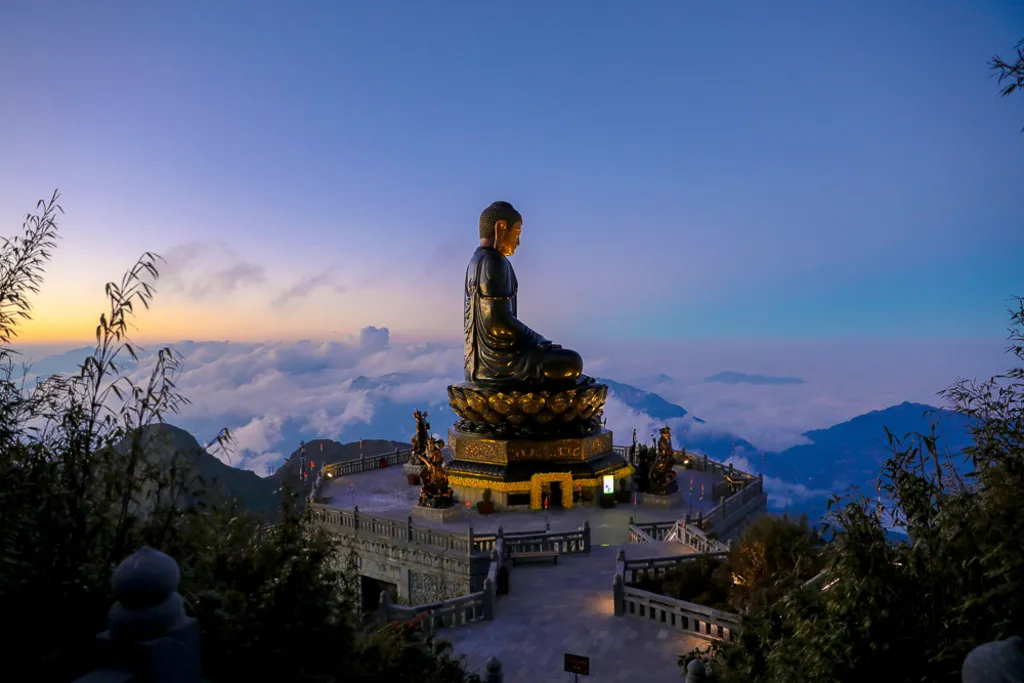 |
| The most breathtaking structure in Fansipan is the Great Statue of Amitabha Buddha |
Perhaps the most breathtaking structure is the Great Statue of Amitabha Buddha, which stands at a towering height of 21.5 meters and weighs 62 tons. This magnificent masterpiece was meticulously crafted from hundreds of thousands of 5 mm thick copper plates and is said to be the highest copper Amitabha Buddha sculpture in all of Asia. Within its confines there is also a seven-storey crystal stupa which serves as a solemn store for sacred relics that belonged to Buddha, an esteemed treasure of profound significance in Buddhist culture that attracts many pilgrims to Mount Fansipan.
'What to do at the foot of Fansipan?'
In addition to the magnificent natural scenery, Sapa is also home to a number of ethnic minority groups and mountain dwelling communities that each have their own distinct cultural identity. Not too long ago, the idea of engaging with the five distinct minority groups – H'Mong, Tay, Giay, Xa Pho and Red Dao – in Sapa within a single day would have been impossible due to geographical distances. However, this can now be achieved at May Village in Sun World Fansipan Legend.
Located at the foot of Fansipan Mountain, near the cable car departure station, May Village is a small community, where these five ethnic groups coexist. Together, they offer visitors a glimpse into their individual cultures, beliefs, artisanal crafts and traditional cuisines. During weekends and local festivals, travellers will have the opportunity to witness the reenactment of ancient customs and rituals, for example, a Red Dao wedding ceremony, the 'catch-hand marriage' of the H'Mong people, and the Roong Pooc Festival which marks the beginning of the Giay people's farming season.
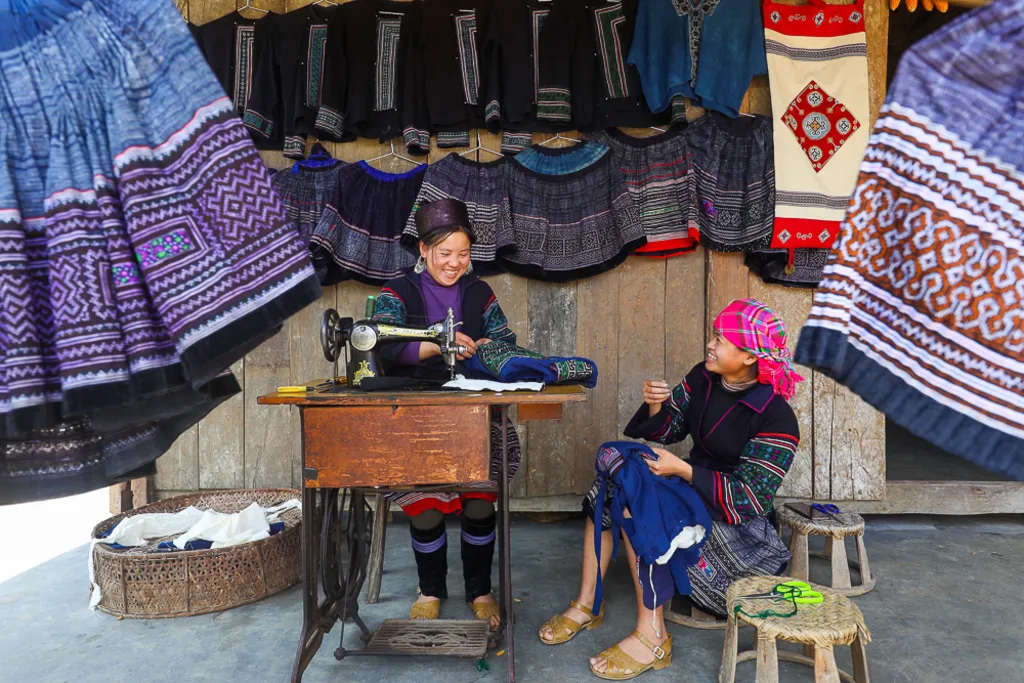 |
| A traditional H’Mong house in May Village |
Every day of the week, May Village also hosts exclusive shows from 9:30 AM to 11:30 AM, and from 1:50 PM to 4:00 PM, inviting visitors to watch and enjoy various artistic performances that highlight the rich cultural diversity of the Northwest region. Visitors can interact with local artists from the Tay and Xa Pho communities before and after watching short shows including 'Little Sapa', 'Northwest in Bloom' and 'The Love of Fansipan’.




